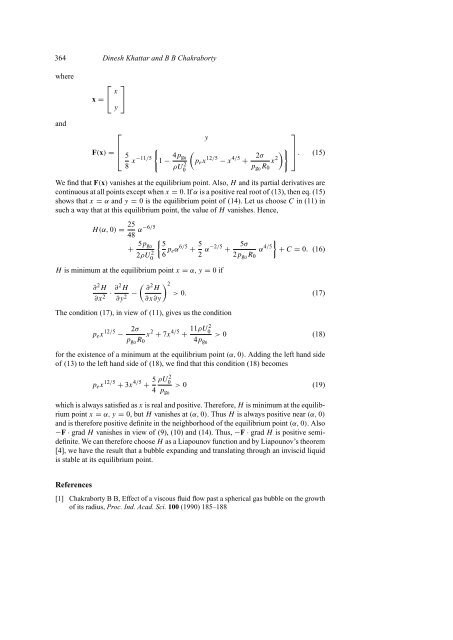Stability of a bubble expanding and translating through an inviscid ...
Stability of a bubble expanding and translating through an inviscid ...
Stability of a bubble expanding and translating through an inviscid ...
Create successful ePaper yourself
Turn your PDF publications into a flip-book with our unique Google optimized e-Paper software.
364 Dinesh Khattar <strong><strong>an</strong>d</strong> B B Chakraborty<br />
where<br />
⎡<br />
x = ⎣ x ⎤<br />
⎦<br />
y<br />
<strong><strong>an</strong>d</strong><br />
F(x) =<br />
⎡<br />
⎢<br />
⎣<br />
y<br />
{<br />
5<br />
8 x−11/5 1 − 4p (<br />
g 0<br />
ρU0<br />
2 p e x 12/5 − x 4/5 +<br />
⎤<br />
2σ ) } ⎥<br />
x 2 ⎦ . (15)<br />
p g0 R 0<br />
We find that F(x) v<strong>an</strong>ishes at the equilibrium point. Also, H <strong><strong>an</strong>d</strong> its partial derivatives are<br />
continuous at all points except when x = 0. If α is a positive real root <strong>of</strong> (13), then eq. (15)<br />
shows that x = α <strong><strong>an</strong>d</strong> y = 0 is the equilibrium point <strong>of</strong> (14). Let us choose C in (11) in<br />
such a way that at this equilibrium point, the value <strong>of</strong> H v<strong>an</strong>ishes. Hence,<br />
H (α, 0) = 25<br />
48 α−6/5<br />
+ 5p g 0<br />
2ρU 2 0<br />
H is minimum at the equilibrium point x = α, y = 0if<br />
∂ 2 H<br />
∂x 2 · ∂2 H<br />
∂y 2<br />
{ 5<br />
6 p eα 6/5 + 5 2 α−2/5 + 5σ<br />
2p g0 R 0<br />
α 4/5 }<br />
+ C = 0. (16)<br />
( ∂ 2 ) 2 − H<br />
> 0. (17)<br />
∂x∂y<br />
The condition (17), in view <strong>of</strong> (11), gives us the condition<br />
p e x 12/5 −<br />
2σ x 2 + 7x 4/5 + 11ρU2 0<br />
> 0 (18)<br />
p g0 R 0 4p g0<br />
for the existence <strong>of</strong> a minimum at the equilibrium point (α, 0). Adding the left h<strong><strong>an</strong>d</strong> side<br />
<strong>of</strong> (13) to the left h<strong><strong>an</strong>d</strong> side <strong>of</strong> (18), we find that this condition (18) becomes<br />
p e x 12/5 + 3x 4/5 + 5 ρU0<br />
2 > 0 (19)<br />
4 p g0<br />
which is always satisfied as x is real <strong><strong>an</strong>d</strong> positive. Therefore, H is minimum at the equilibrium<br />
point x = α, y = 0, but H v<strong>an</strong>ishes at (α, 0). Thus H is always positive near (α, 0)<br />
<strong><strong>an</strong>d</strong> is therefore positive definite in the neighborhood <strong>of</strong> the equilibrium point (α, 0). Also<br />
−F · grad H v<strong>an</strong>ishes in view <strong>of</strong> (9), (10) <strong><strong>an</strong>d</strong> (14). Thus, −F · grad H is positive semidefinite.<br />
We c<strong>an</strong> therefore choose H as a Liapounov function <strong><strong>an</strong>d</strong> by Liapounov’s theorem<br />
[4], we have the result that a <strong>bubble</strong> <strong>exp<strong><strong>an</strong>d</strong>ing</strong> <strong><strong>an</strong>d</strong> <strong>tr<strong>an</strong>slating</strong> <strong>through</strong> <strong>an</strong> <strong>inviscid</strong> liquid<br />
is stable at its equilibrium point.<br />
References<br />
[1] Chakraborty B B, Effect <strong>of</strong> a viscous fluid flow past a spherical gas <strong>bubble</strong> on the growth<br />
<strong>of</strong> its radius, Proc. Ind. Acad. Sci. 100 (1990) 185–188
















